Serving 381 students in grades 8-12, Monserrate Leon Irizarry ranks in the top 50% of all schools in Puerto Rico for overall test scores (math proficiency is bottom 50%, and reading proficiency is bottom 50%).
The percentage of students achieving proficiency in math is ≤5% (which is lower than the Puerto Rico state average of 21%). The percentage of students achieving proficiency in reading/language arts is 50-54% (which is higher than the Puerto Rico state average of 36%).
The student:teacher ratio of 15:1 is higher than the Puerto Rico state level of 10:1.
Quick Stats (2025)
- Grades: 8-12
- Enrollment: 381 students
- Student:Teacher Ratio: 15:1
- Graduation Rate: 70-74% (Btm 50% in PR)
- Overall Testing Rank: Top 50%
- Math Proficiency: ≤5% (Btm 50%)
- Reading Proficiency: 50-54% (Top 20%)
- Science Proficiency: 50-54% (Top 30%)
- Source: National Center for Education Statistics (NCES), PR Dept. of Education
Top Rankings
Monserrate Leon Irizarry ranks among the top 20% of public schools in Puerto Rico for:
Category
Attribute
Reading/Language Arts Proficiency
Percent Eligible For Free Lunch
School Overview
Monserrate Leon Irizarry's student population of 381 students has declined by 24% over five school years.
The teacher population of 26 teachers has declined by 25% over five school years.
Grades Offered
Grades 8-12
Total Students
381 students
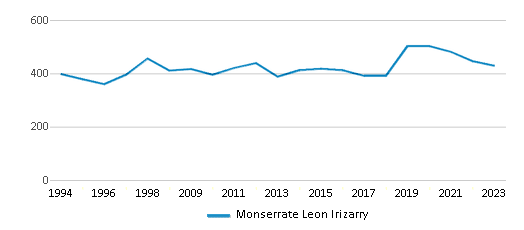
Gender %
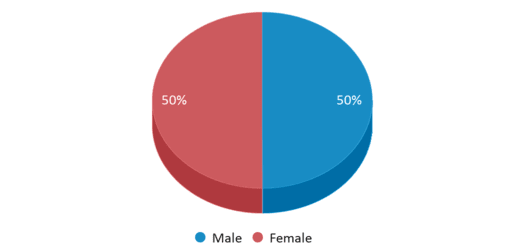
Total Classroom Teachers
26 teachers
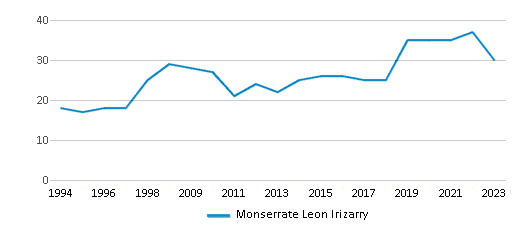
Students by Grade
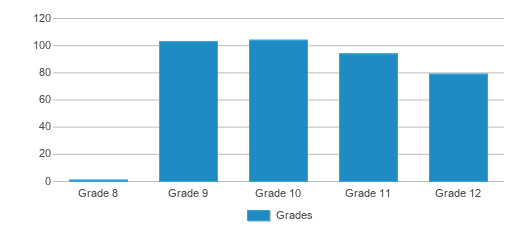
School Rankings
Monserrate Leon Irizarry ranks within the top 50% of all 839 schools in Puerto Rico (based off of combined math and reading proficiency testing data).
The diversity score of Monserrate Leon Irizarry is 0.00, which is less than the diversity score at state average of 0.01. The school's diversity has stayed relatively flat over five school years.
Overall Testing Rank
#358 out of 839 schools
(Top 50%)
(Top 50%)
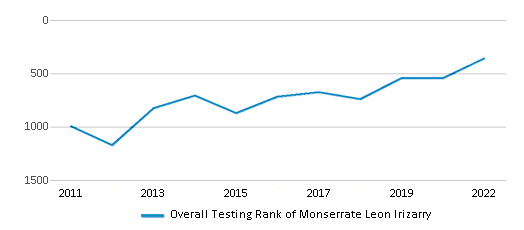
Math Test Scores (% Proficient)
≤5%
21%
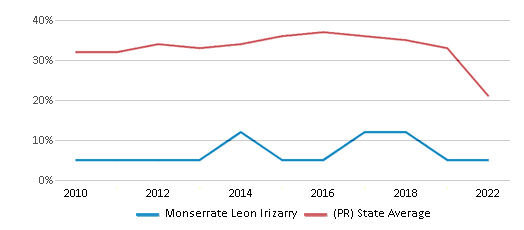
Reading/Language Arts Test Scores (% Proficient)
50-54%
36%
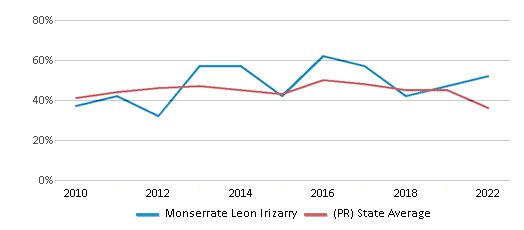
Science Test Scores (% Proficient)
50-54%
36%
Student : Teacher Ratio
15:1
10:1
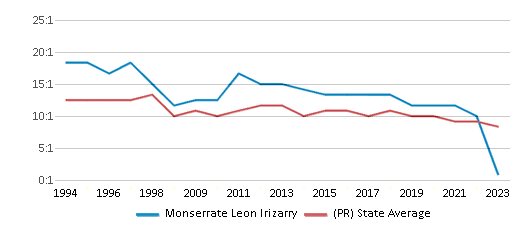
American Indian
n/a
n/a
Asian
n/a
n/a
Hispanic
100%
100%
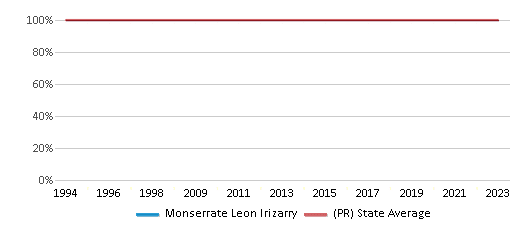
Black
n/a
n/a
White
n/a
n/a
Hawaiian
n/a
n/a
Two or more races
n/a
n/a
All Ethnic Groups
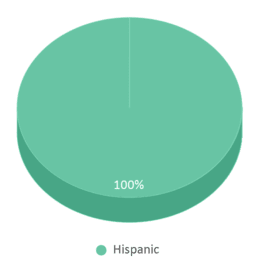
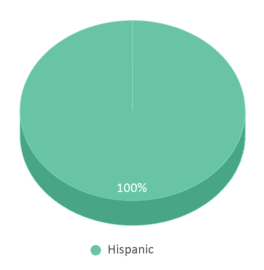
Graduation Rate
70-74%
74%
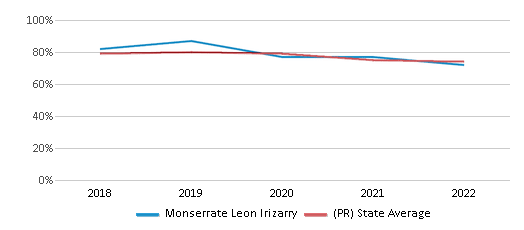
Participates in the National School Lunch Program (NSLP)
Yes
Eligible for Free Lunch
85%
85%
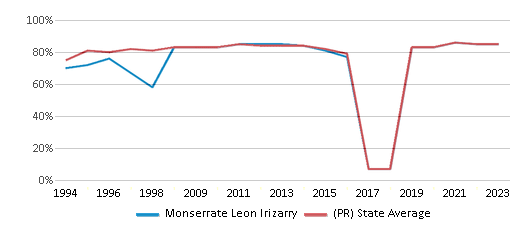
Eligible for Reduced Lunch
7%
6%
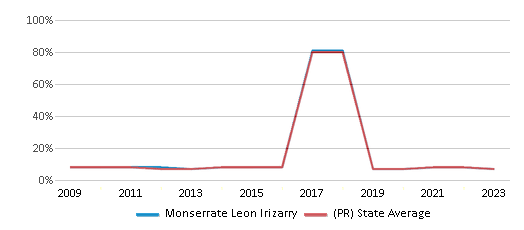
School Statewide Testing
School District Name
Source: National Center for Education Statistics (NCES), PR Dept. of Education
Profile last updated: 02/09/2025
Frequently Asked Questions
What is Monserrate Leon Irizarry's ranking?
Monserrate Leon Irizarry is ranked #358 out of 839 schools, which ranks it among the top 50% of public schools in Puerto Rico.
What percent of students have achieved state testing proficiency in math and reading?
≤5% of students have achieved math proficiency (compared to the 21% PR state average), while 50-54% of students have achieved reading proficiency (compared to the 36% PR state average).
What is the graduation rate of Monserrate Leon Irizarry?
The graduation rate of Monserrate Leon Irizarry is 70-74%, which is lower than the Puerto Rico state average of 74%.
How many students attend Monserrate Leon Irizarry?
381 students attend Monserrate Leon Irizarry.
What is the racial composition of the student body?
100% of Monserrate Leon Irizarry students are Hispanic.
What is the student:teacher ratio of Monserrate Leon Irizarry?
Monserrate Leon Irizarry has a student ration of 15:1, which is higher than the Puerto Rico state average of 10:1.
What grades does Monserrate Leon Irizarry offer ?
Monserrate Leon Irizarry offers enrollment in grades 8-12
What school district is Monserrate Leon Irizarry part of?
Monserrate Leon Irizarry is part of Puerto Rico Department Of Education School District.
School Reviews
2 3/26/2020
The school is not that bad, but some teachers and students ruin it. The facilities are run down and old, there are rarely any materials for the students, no paper rolls in the bathrooms or soap. The teachers participate in gossip and some of them even turn a blind eye to the bullying that happens in front of them. They also impose their beliefs on the students specially the director and one of the Spanish teachers, they do this even though they are not supposed to force their Christianity onto the students. They force them to stand up and pray when doing events and if they don't they are flagged as a bad kid; some teachers even give you more assignments as punishment, specially the Spanish teacher from 12 grade, she forced students to write essays about why some behaviors were wrong and why they should be sorry even though it was only one student displaying that behavior, still everyone got another assignment they didn't need to do just because she could not keep under control that one student. Other than all these things mentioned before I would like to mention some good personnel from that school; those being the English teacher for 12 grade and the librarian. They were both very nice people who did their best with what little they were given.
Review Monserrate Leon Irizarry. Reviews should be a few sentences in length. Please include any comments on:
- Quality of academic programs, teachers, and facilities
- Availability of music, art, sports and other extracurricular activities
Recent Articles

What Is A Charter School?
Explore the world of charter schools in this comprehensive guide. Learn about their history, how they operate, and the pros and cons of this educational innovation. Discover key facts about charter schools, including admission policies, demographics, and funding, as well as what to look for when considering a charter school for your child.

10 Reasons Why High School Sports Benefit Students
Discover the 10 compelling reasons why high school sports are beneficial for students. This comprehensive article explores how athletics enhance academic performance, foster personal growth, and develop crucial life skills. From improved fitness and time management to leadership development and community representation, learn why participating in high school sports can be a game-changer for students' overall success and well-being.

February 05, 2025
Understanding the U.S. Department of Education: Structure, Impact, and EvolutionWe explore how the Department of Education shapes American education, from its cabinet-level leadership to its impact on millions of students, written for general audiences seeking clarity on this vital institution.






